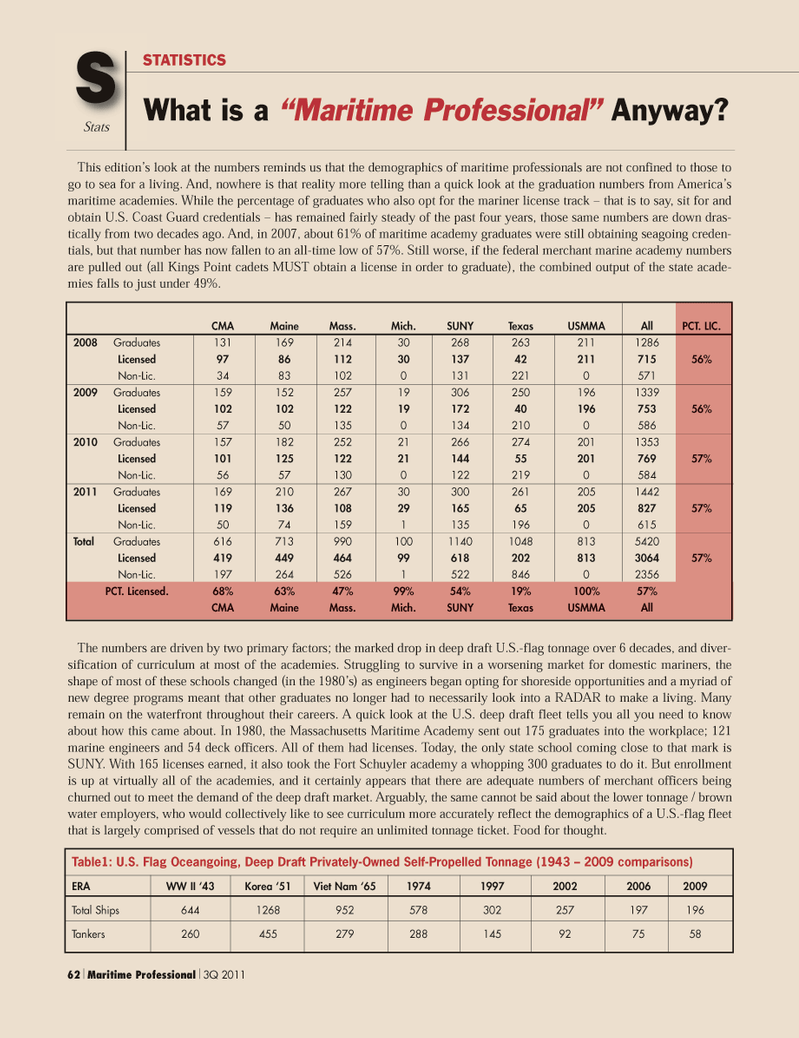
Page 62: of Maritime Logistics Professional Magazine (Q3 2011)
Maritime Security / Maritime Training & Education
Read this page in Pdf, Flash or Html5 edition of Q3 2011 Maritime Logistics Professional Magazine
62 Maritime Professional 3Q 2011This edition?s look at the numbers reminds us that the demographics of maritime professionals are not confined to those to go to sea for a living. And, nowhere is that reality more telling than a quick look at the graduation numbers from America?s maritime academies. While the percentage of graduates who also opt for the mariner license track ? that is to say, sit for and obtain U.S. Coast Guard credentials ? has remained fairly steady of the past four years, those same numbers are down dras- tically from two decades ago. And, in 2007, about 61% of maritime academy graduates were still obtaining seagoing creden- tials, but that number has now fallen to an all-time low of 57%. Still worse, if the federal merchant marine academy numbers are pulled out (all Kings Point cadets MUST obtain a license in order to graduate), the combined output of the state acade-mies falls to just under 49%. The numbers are driven by two primary factors; the marked drop in deep draft U.S.-flag tonnage over 6 decades, and diver- sification of curriculum at most of the academies. Struggling to survive in a worsening market for domestic mariners, the shape of most of these schools changed (in the 1980?s) as engineers began opting for shoreside opportunities and a myriad of new degree programs meant that other graduates no longer had to necessarily look into a RADAR to make a living. Many remain on the waterfront throughout their careers. A quick look at the U.S. deep draft fleet tells you all you need to know about how this came about. In 1980, the Massachusetts Maritime Academy sent out 175 graduates into the workplace; 121 marine engineers and 54 deck officers. All of them had licenses. Today, the only state school coming close to that mark is SUNY. With 165 licenses earned, it also took the Fort Schuyler academy a whopping 300 graduates to do it. But enrollment is up at virtually all of the academies, and it certainly appears that there are adequate numbers of merchant officers being churned out to meet the demand of the deep draft market. Arguably, the same cannot be said about the lower tonnage / brown water employers, who would collectively like to see curriculum more accurately reflect the demographics of a U.S.-flag fleet that is largely comprised of vessels that do not require an unlimited tonnage ticket. Food for thought. SStatsWhat is a ?Maritime Professional?Anyway?STATISTICS CMAMaineMass.Mich.SUNYTexasUSMMAAllPCT. LIC. 2008Graduates131169214302682632111286 Licensed9786112301374221171556% Non-Lic.348310201312210571 2009Graduates159152257193062501961339 Licensed102102122191724019675356% Non-Lic.575013501342100586 2010Graduates157182252212662742011353 Licensed101125122211445520176957% Non-Lic.565713001222190584 2011Graduates169210267303002612051442 Licensed119136108291656520582757% Non-Lic.507415911351960615 Total Graduates616713990100114010488135420 Licensed41944946499618202813306457% Non-Lic.197264526152284602356 PCT. Licensed.68%63%47%99%54%19%100%57% CMAMaineMass.Mich.SUNYTexasUSMMAAll Table1: U.S. Flag Oceangoing, Deep Draft Privately-Owned Self-Propelled Tonnage (1943 ? 2009 comparisons) ERAWW II ?43Korea ?51Viet Nam ?6519741997200220062009 Total Ships 6441268952578302257197196 Tankers 260455279288145927558 MP #3 (50-64):MP Layouts 8/17/2011 4:52 PM Page 62

 61
61

 63
63
